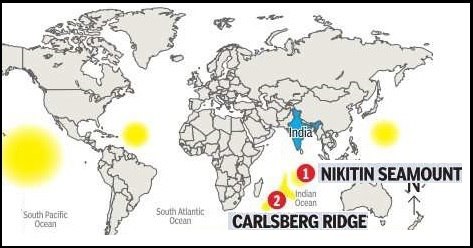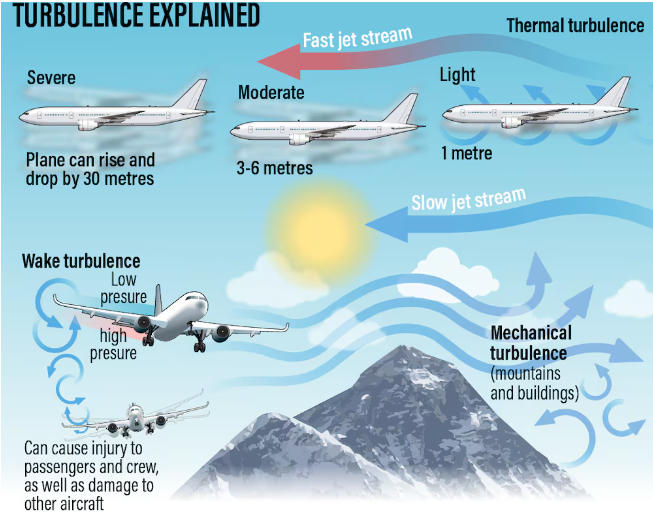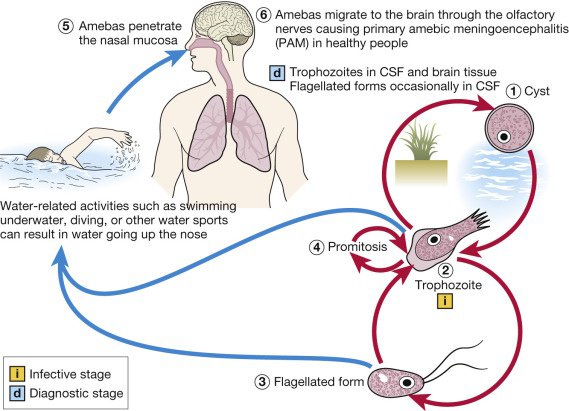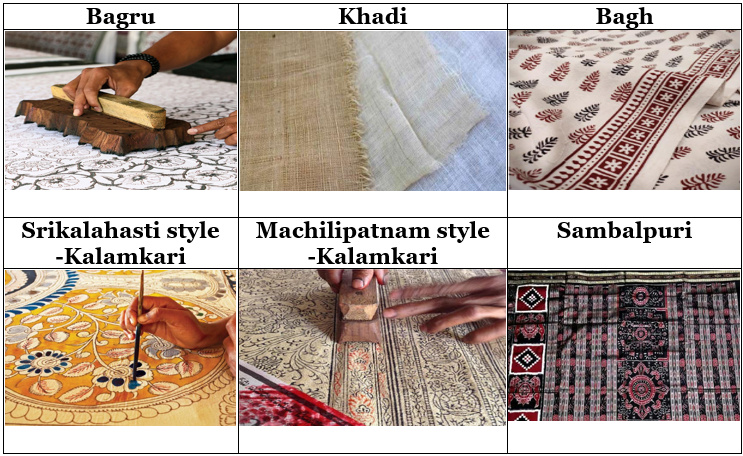Carlsberg Ridge & Afanasy-Nikitin Seamount
Indian delegates have been visiting the International Seabed Authority (ISA), Jamaica to strengthen efforts to explore 2 deep sea regions in the Indian Ocean for mining.
- Carlsberg Ridge – It is located away from India’s western shores, a region between Africa and India in the Indian Ocean.
- Running along Seychelles and spanning 3, 00,000 sq kms.
- Features – It is the northern part of the Central Indian Ridge, a tectonic plate boundary between the African and Indian plates.
- It formed nearly 30 million years ago and seismically active with major earthquakes.
- Mineral resources – Rich in polymetallic nodules, and is thought to contain trace elements of copper, lead, and zinc.
Polymetallic Nodules occur in lumps in the seabed of tectonically active regions. When emitted from hydrothermal vents, these metals occur as sulphides that are rich in gold and silver, as well as manganese, zinc, and cobalt.
Afanasy-Nikitin Seamount (ANS)
- Located in – The Central Indian Basin, that is southeast to Sri Lanka, right below the equator, to the west of Singapore.
- It is about 3,000 km from India’s coast.
- Features – It rises up above the sea bed but below the surface, and forming a seamount, was formed about 80 million years ago.
- It is 400 km long and 150 km wide.
- Mineral resources – It is a cobalt-rich ferromanganese crusts that is rich in cobalt, copper, manganese, and nickel.
- Contention – Sri Lanka claim the Seamount as its own territory as countries in the Bay of Bengal region can utilise a different set of criteria that allows a claim of up to 500 nautical miles.

Exploration and mining in international maritime waters (beyond 200 nautical miles from coastal boundary) requires permission from the international body ‘International Seabed Authority’, an independent and autonomous organisation established under the United Nations.
|
Application of Deep Sea Mined Minerals
|
- Cobalt - In electronics, batteries and to make solar and wind power infrastructure as well.
- Nickel – In electric vehicles as it is resistant to corrosion & oxidation.
- Manganese – Used for lithium ion and alkaline batteries.
- Copper – Used in electricity.
|
Reference
The Print| India’s plans to mine 2 mineral-rich Indian Ocean regions
Aircraft Turbulence
Passenger were injured after a Singapore Airlines flight from London to Singapore hit severe turbulence.
- Turbulence – A sudden and violent shift in airflow, can felt as jolts or vibrations making aircraft movement less stable and comfortable.
- Causes – The most obvious is unstable weather patterns that trigger storms, which can be detected by weather radar.
- Atmospheric factors – wind shear or convective currents.
- Physical factors – Like mountains and buildings
- Clean air turbulence (CAT) – A sudden and severe swirl that causes violent buffeting of a plane even where there are no clouds.
- Such invisible pockets of air can appear without warning, and are hard to predict.

- Frequency – Turbulence-related incidents are common, according to a 2021 study by the U.S. National Transportation Safety Board.
- Impact on passengers – From 2009 through 2018, turbulence resulted in one or more serious injuries, but no aircraft damage.
- Yet fatal turbulence in air travel remains extremely rare.
- Impact on planes – Long planes can feel most turbulent at the back and the ideal spot is around the centre of gravity, which is typically just ahead of the wings.
- The feeling experienced by passengers varies from plane to plane and seat to seat.
- Preparedness – Loading extra fuel when needed and monitoring weather radar during flight.
- Measures – NASA is developing an early-warning system that relies on ground-mounted infrasonic microphones to detect clear-air turbulence hundreds of kilometers away.
Boeing's high-tech 787-9, with a "Gust Alleviation System" from Honeywell, ranks 1st for handling turbulence followed by the Airbus A340-500/600.
- Links with climate change – A report from the University of Reading suggested turbulence could worsen with climate change.
- However, while there seems to be a strong correlation, more research is needed.
Reference
The Hindu| Aircraft turbulence impacting passengers
Naegleria fowleri
A five-year-old girl in Kerala died due to the infection caused by Naegleria fowleri.
- It is a free-living amoeba or a single-celled living organism.
- Growing conditions – Higher temperatures of up to 115°F (46°C) are conducive to its growth and it can survive for short periods in warm environments.
- Occurrences – It lives in warm fresh water and soil around the world.
- Infection – It enters the body through the nose, usually when people are swimming and then travels up to the brain, where it destroys the brain tissue and causes swelling.
- Thus it is also known as brain-eating amoeba.
People cannot get infected with Naegleria fowleri from drinking water contaminated with the amoeba.

Primary amebic meningoencephalitis (PAM)
There have been 20 reported cases of PAM in India.
- It is a rare brain infection, caused by the amoeba Naegleria fowleri.
- It is a non-communicable disease.
- Symptoms – In the initial stage, the symptoms include headache, fever, nausea and vomiting.
- Later on, the patient may have a stiff neck and experience confusion, seizures, hallucinations and slip into a state of coma.
According to the US Centers for Disease Control and Prevention (CDC), “Most people with PAM die within 1 to 18 days after symptoms begin. It usually leads to coma and death after 5 days.”
- Treatment – Still scientists haven’t been able to identify any effective treatments for the disease yet.
- At present, a combination of drugs, including amphotericin B, azithromycin, fluconazole, rifampin, miltefosine, and dexamethasone are used.
References
- The Indian Express| Naegleria fowleri causes a rare brain infection
- CDC| Naegleria fowleri Infection
Bharal & ibex
‘Bharal’ and ibex are major prey of snow leopards whose numbers have recently seen a rebound.
Snow leopards, the apex predator of High Mountain Asia, are classified as ‘vulnerable’ under the IUCN’s Red List of endangered species.
- Bharal – Also known as blue sheep.
- Scientific name – Pseudois nayaur
- Distribution – It is a caprine native to the high Himalayas region of Bhutan, China, India, Myanmar, Nepal, Pakistan
- Habitat – They live on open grassy slopes in high mountains and are usually found near cliffs but try to avoid forested areas.
- They are tolerant of extreme weather conditions and can be found from Desert Mountains in searing heat to windy and cold slopes.
- Features – The short, dense coat is slate grey in colour, sometimes with a bluish shine.
- Due to their excellent camouflage and the absence of cover in their environment, it remain motionless when approached.
- Lifestyle – Terrestrial, grazing, viviparous, social animal but not a seasonal migrant.
- Protection status
Ibex
- It refers to several species of wild goat (genus Capra).
- Features – It is distinguished by the male's large recurved horns, which are transversely ridged in front.
- Distribution – Eurasia, North Africa and East Africa.
- In Asia – In elevations from 500 m to 6,700 m in countries like India, Kazakhstan, Tajikistan, Mongolia, Pakistan, Southern Siberia and China.
- In India – In the trans-Himalayan ranges of the UTs of Ladakh and Jammu & Kashmir and Himachal Pradesh.
- Habitat – Cold deserts, rocky outcrops, steep terrain, high-land flats and mountain ridges to low mountains and foothills.
- Different types – Asian ibex (Siberian), Alphine ibex, Iberian ibex, Nubian ibex, Ethiopian ibex (Walia) and West Asian ibex.
A recent genetic study by the Zoological Survey of India (ZSI) has proved that Himalayan ibex found in India is a distinct species from the Siberian Ibex.
- Protection – IUCN Red List
- Vulnerable – Nubian ibex & Walia ibex
- Near threatened – Siberian ibex
- Least concern – Aplhine ibex & Iberian wild goat
There is a complete ban on hunting of all types of wild animals including blue sheep and Himalayan ibex in Lahaul & Spiti.
References
- Down to Earth|Census started in Himachal Pradesh
- Animalia| Bharal, the Himalayan blue sheep
Textile prints of India
Today, India is home to some popular textiles of the world.
- Historical relevance – India has been well known for its textiles since ancient times with their origin tracing back to the Indus Valley civilization since the 5th millennium BC.
|
Styles
|
Characteristics
|
|
Bagru textiles
|
- Process – Block printing.
- Here, the wooden blocks are transformed into motifs with special features on a light-colored background with different prints and styles.
|
|
Khadi
|
- Process – Hand spun, fibers are spun into a yarn on a spinning wheel called a Charkha.
- History – Known as Khaddar during the British era and aligns with the Swadeshi movement.
- Versatility – It has a warm end in winter and a cooling end in the summers.
|
|
Bagh
|
- Process – Hand block print using natural colors.
- Its name is derived from the village Bagh on the banks of the Bagh River in Madhya Pradesh.
- Features – A geometric and floral motifs using a vegetable color over a white background.
|
|
Kalamkari
|
- Process – A type of hand-painted or block-printed cotton textile.
- There are 2 types of distinctive styles.
- Srikalahasti style – It involves a pen for freehand drawing of patterns and filling in the colors which is pure hand worked.
- Machilipatnam style – It involves vegetable-dyed block-painting of a fabric.
|
|
Sambalpuri
|
- Process – Handwoven, where the threads are initially tie-dyed and later woven into a fabric.
- Features – The traditional motifs such as shell, wheel, and flower.
|

Reference
Times of India| Textile Prints of India



